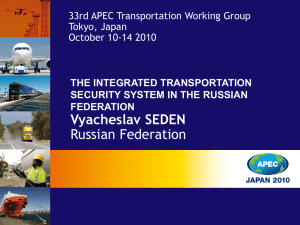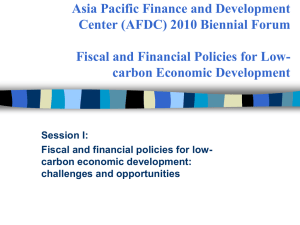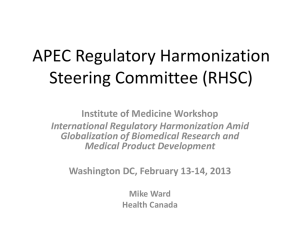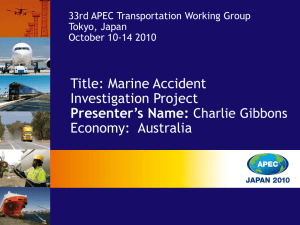Project Proposal: Road Safety Measures for Heavy Vehicles in
advertisement
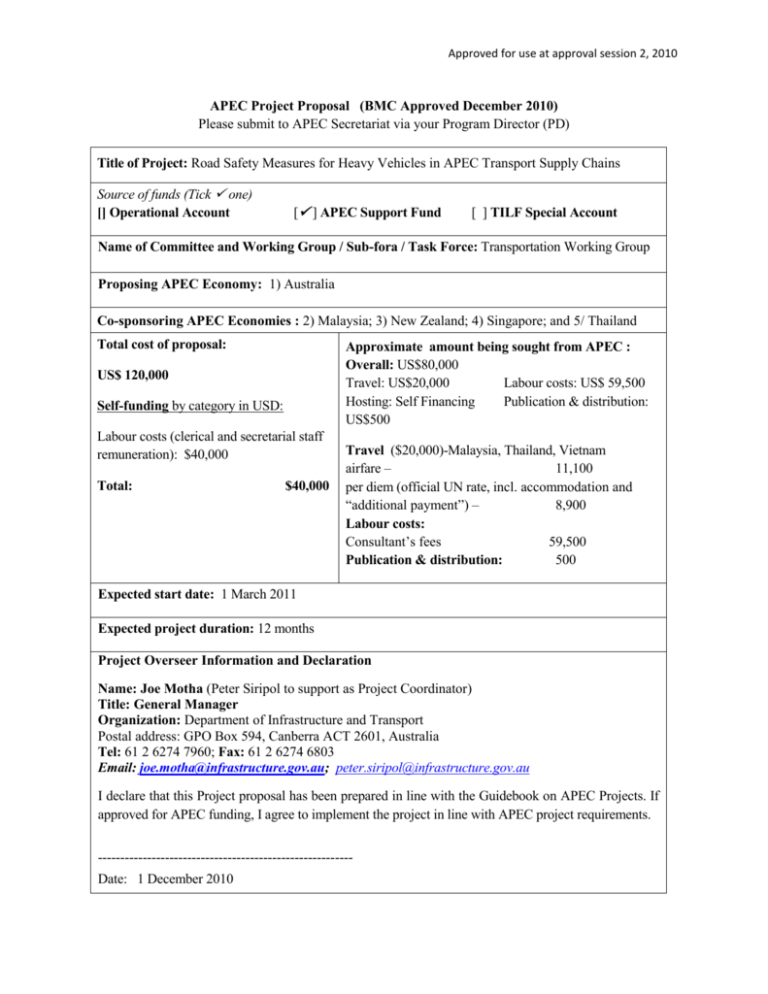
Approved for use at approval session 2, 2010 APEC Project Proposal (BMC Approved December 2010) Please submit to APEC Secretariat via your Program Director (PD) Title of Project: Road Safety Measures for Heavy Vehicles in APEC Transport Supply Chains Source of funds (Tick one) [] Operational Account [ ] APEC Support Fund [ ] TILF Special Account Name of Committee and Working Group / Sub-fora / Task Force: Transportation Working Group Proposing APEC Economy: 1) Australia Co-sponsoring APEC Economies : 2) Malaysia; 3) New Zealand; 4) Singapore; and 5/ Thailand Total cost of proposal: Approximate amount being sought from APEC : Overall: US$80,000 Travel: US$20,000 Labour costs: US$ 59,500 Hosting: Self Financing Publication & distribution: US$500 US$ 120,000 Self-funding by category in USD: Labour costs (clerical and secretarial staff remuneration): $40,000 Total: $40,000 Travel ($20,000)-Malaysia, Thailand, Vietnam airfare – 11,100 per diem (official UN rate, incl. accommodation and “additional payment”) – 8,900 Labour costs: Consultant’s fees 59,500 Publication & distribution: 500 Expected start date: 1 March 2011 Expected project duration: 12 months Project Overseer Information and Declaration Name: Joe Motha (Peter Siripol to support as Project Coordinator) Title: General Manager Organization: Department of Infrastructure and Transport Postal address: GPO Box 594, Canberra ACT 2601, Australia Tel: 61 2 6274 7960; Fax: 61 2 6274 6803 Email: joe.motha@infrastructure.gov.au; peter.siripol@infrastructure.gov.au I declare that this Project proposal has been prepared in line with the Guidebook on APEC Projects. If approved for APEC funding, I agree to implement the project in line with APEC project requirements. --------------------------------------------------------Date: 1 December 2010 Approved for use at approval session 2, 2010 APEC Project Proposal Please provide your answers in point form or as succinctly as possible below each paragraph heading. Note: The project in an industry perspective is provided at Attachment A. A. Relevance to APEC 1. Briefly describe the project in one or two paragraphs. What are you seeking APEC funding for? The project seeks APEC funding to empower developing economies to develop their own road safety measures for heavy vehicles in APEC transport supply chains. Improving heavy vehicle safety offers the potential to greatly improve supply chain productivity through lower costs relating to road crashes. These costs include costs to families, communities and businesses resulting from loss of life and temporary and permanent injuries, insurance costs, downtime and delay, training costs for replacement workers and equipment, and infrastructure damage and replacement costs. Overall project outcomes will support development of a more efficient and advanced infrastructure and logistics network which will facilitate clearance of goods and services across and within borders.Specific issues to be addressed by this project will include: - Strategies for the social marketing of road safety measures – particularly best practices – which have resulted in positive change and offered the prospect of further improvements. Approaches to planning, funding and priority setting for road infrastructure and network operations and management. Standards for safety in vehicles and safe use of vehicles, including use of emerging technologies such as digital tachographs and GPS-based tracking systems which enable safe driving and operating practices to be monitored. 2. Describe the key objectives of the project. (Usually no more than three.) For shorter-term projects such as workshops or training, describe the objectives for participants: “By the end of the training, participants/trainees will be able to…” The key objectives of the project are three fold: Objective 1: To identify, through research and case studies, road safety issues relating to heavy vehicles in selected APEC economies and the economic impacts on the supply chain of heavy vehicle crashes. In addition, identify any barriers that exist to improving safety. This will include, to the extent possible, any gender-related barriers and the collection of gender-disaggregated data. Objective 2: To raise awareness of options to address road safety strategies relating to heavy vehicles, planning and funding approaches, and standards and technologies to improve safety and address variations in cross-border standards that impede the smooth flow of goods, services and people. Objective 3: To develop and make available to all economies a compendium of road safety measures for heavy vehicles in the transport supply chain industry with a view to promoting best practice implementation approaches and alignment of standards as well as learning from success stories. The compendium will include measures to address driver fatigue, a Safety Code of Practice for Heavy Approved for use at approval session 2, 2010 Vehicles, and address issues relating to improving driver efficiency through a Professional Driver Training Program, initially for developing economies. A workshop on project findings will be arranged as part of a meeting of the APEC Transportation Working Group to put in place a process to assist developing economies to build capacity in the supply chain including appropriate measures in their national road safety strategies and action plans. 3. In less than half a page, briefly describe how the project directly responds to APEC’s key priorities and your fora’s work plan /medium term plan. The project is in response to directives from APEC Leaders and Transportation Ministers. The project also meets the TPT-WG’s priorities relating to the APEC Supply Chain Connectivity Framework. At their meeting on 8 February 2010 in Melbourne, Australia, Regional Transport Ministers or their representatives from Australia, Malaysia, New Zealand, Singapore and Thailand agreed that Australia with Malaysia, New Zealand, Singapore and Thailand develop a project to document and exchange information on case studies and local experience on road safety measures and safety standards for heavy vehicles. The project responds to Chokepoint 7 (variations in standards across the border re road safety standards) of the APEC Supply Chain Connectivity Framework, endorsed by APEC Leaders in 2009. In 2009, APEC Leaders committed to accelerate APEC’s work in strengthening economic growth and consequent economic integration in the APEC region. This work will be undertaken through a comprehensive approach that focuses on trade liberalisation ‘at the border’; improving the business environment ‘behind the border’; and enhancing supply chain connectivity ‘across the border’. In particular, the project will demonstrate how national logistics initiatives can minimise the impacts of government policies and regulation on industry. In their Yokohama Declaration in November 2010, APEC Leaders emphasised their commitment to the APEC Supply Chain Connectivity Framework Action Plan with a view to achieving an APEC-wide target of a ten per cent improvement in supply chain performance by 2015. This target is to be achieved in terms of reduction of time, cost, and uncertainty of moving goods and services through the Asia-Pacific region, taking into consideration the circumstances of individual economies. 4. For applications under the TILF Special Account: Briefly describe how the project will contribute to APEC trade and investment liberalization and facilitation with reference to specific parts of the Osaka Action Agenda. The project seeks funds under the APEC Support Fund Human Safety and Security Sub-fund on the basis that it would result in capacity building in heavy vehicle safety, particularly for APEC developing economies. The project essentially involves research and sharing information and experience relating to ECOTECH aimed at achieving sustainable growth and equitable development while improving economic and social well-being. Approved for use at approval session 2, 2010 B. Project Effectiveness 5. Describe the project’s methodology in 1-2 pages. This section should include how the project will be monitored and assessed. For each step, include: a. How it will be carried out b. How member economies and beneficiaries will be involved c. Any risks involved and how they will be managed d. Associated outputs for each step Methodology Phase One (March-April 2011) – Scoping and needs assessment To commence the project, the Project Overseer will lead a consultative process with the successful consultant to ensure effective coordination with stakeholders (government and industry) and ABAC Australia, covering: scoping for the project and timeframe; research approach on the roles of heavy vehicles in the transport logistics industry, focusing on key developing and developed economies; existing road safety costs, measures to address road safety issues and barriers to implementing measures; and designing a survey with a view to developing appropriate case studies. Key government and industry stakeholders in selected developing economies will also be consulted in developing the project scope and survey design. A robust evaluation process based on the APEC Framework for Project Evaluation will be established from project commencement. Evaluation issues will include: the results of the project; the extent to which the project contributed to capacity building; and effectiveness of information sharing on best practices and lessons learned. The project will be considered mainly by LEG, with inputs from the Intermodal ITS Experts Group (IIEG) in regard to technologies for heavy vehicle safety. Risks for desired Phase One outcomes may include: - Possible delay in the provision of a questionnaire, due to the consultant’s inability to comply with the timetable or poor quality questionnaire Tardy or poor replies by economies Lack of interest by IIEG. Remedies Selection of a competent and suitable consultant: The Project Overseer, in close consultation with the APEC Secretariat and co-sponsoring economies, will apply a thorough consultant selection process to Approved for use at approval session 2, 2010 ensure a competent consultant is selected. A panel with relevant experience and knowledge will be appointed for the selection process and the process will draw on lessons learned from recent selection processes. Particular attention will be given to evidence of proven achievements and references. Bidders will be required to succinctly address the essential requirements of the project (value for money, delivery in time and within budget), outlined in the Request for Proposal. Planning and questionnaire: The Project Overseer will ensure that the consultant clearly understands the project objectives, scope, beneficiaries and desired outcomes as a basis for questionnaire design, while also considering the structure and content of the compendium. The questionnaire is intended to be comprehensive, self-explanatory and user-friendly with clear instructions to facilitate useful responses. Economies & beneficiaries: The Project Overseer will ensure close and effective collaboration with key economies that participated in the Melbourne Ministerial meeting in February 2010: Australia, Malaysia, New Zealand, Singapore and Thailand. Australia has been working closely with target economies Malaysia, Singapore, Thailand and Vietnam on other TPT-WG road safety initiatives. These economies provided support for this project at the last TPT-WG meeting in October 2010 in Tokyo and will continue to actively participate in the project if it is approved by the BMC. The Project Overseer, who is also Chair of the TPT-WG Land Experts Group – LEG), will also seek input from LEG members and ABAC Australia which will in turn liaise with ABAC and other key industry stakeholders. This project proposal has been developed in response to an initiative by ABAC Australia and the proposal has received support from ABAC in target economies. ABAC Australia has been providing recent ABAC meetings with progress reports on this project proposal. A follow-up system will be put in place to improve questionnaire response. The consultant will be required to undertake additional research, as necessary, to ensure sufficient information is obtained for Phase One and subsequent actions. Collaboration with IIEG: The Chair of LEG will collaborate with the IIEG Chair to that ensure inputs on relevant vehicle safety technologies are considered and that progress of the project is considered at TPTWG (both in-session and out-of-session). Phases Two and Three (May/June/July 2011) Phase Two (May/June) will commence with the conduct of the survey; follow-up and analysis of survey outcomes; preliminary assessment of case studies; and fleshing out compendium structure. A progress report will be prepared for TPT-WG34 which will be held from 13 to17 June 2011, in Brisbane, Australia. The measures selected for inclusion in the compendium will have regard to the particular circumstances and needs of APEC economies. As far as possible, the measures will be evidence-based and supported by appropriate references, details and examples. Photographs and diagrams will be included as far as possible. Member economies, beneficiaries and key stakeholders, including ABAC Australia, from Phase One will continue to provide input to these two phases. Approved for use at approval session 2, 2010 Phases Two and Three will involve follow-up for additional information from economies and additional research and consultation with key stakeholders before proceeding to Phase Four. In mid July 2011, the consultant will visit key developing economies (Malaysia, Thailand and Vietnam) to follow-up input to the questionnaire, with a view to developing a framework for road safety measures for heavy vehicles. Phase Three will also provide language input to a draft Joint Statement for the 7th APEC Transportation Ministerial Meeting (TMM7) to be held in September 2011 in the USA. Risks: A major risk could be inadequate and/or poor quality responses to the questionnaire. Another risk could be a delay in the delivery of the final report and compendium. In addition, the visits by the consultant may not be as useful as expected. Remedies: At TPT-WG34, the Project Overseer will facilitate a discussion on project progress at meetings of LEG and IIEG and will encourage economies to provide timely and quality responses. The Project Overseer will use TPT-WG networks and working relationships to follow up responses or seek additional information or clarification with relevant economies by explaining the importance of quality replies for the success of the project. At all stages, the Project Overseer will work closely with the consultant to ensure the project schedule is followed and the project outputs are delivered on time. Program Director Andrey Plam and the Lead Shepherd will be kept informed of progress or issues relating to the project. Any issues will be addressed as soon as possible to avoid escalation. The Project Overseer will develop a visit program for discussion with relevant officials in Malaysia, Thailand and Vietnam. The program will cover specific questions and other related issues to advance the project in an effective manner, with clear scope of desired outcomes. This process will ensure productive outcomes of the visits. Phases Four and Five [October – December 2011] – Workshop and project sustainability Phase Four: A workshop on the draft report and compendium will be held in conjunction with TPTWG35 in October 2011, with a view to finalising findings and recommendations and exploring an approach to sustain the project as an on-going task for the TPT-WG (LEG with IIEG). It is expected that the workshop will be attended predominantly by members of the LEG, although all economies will be invited. The Chair and Deputy Chair of the IIEG, ABAC Australia and other key stakeholders will be invited to attend. Key industry stakeholders to be consulted and invited will include major logistics companies such as Linfox and Toll Logistics. In addition, Europe-based agencies responsible for digital tachographs1 and GPS-based tracking systems for truck safety will also be invited to collaborate. Phase Five will involve a revision of the draft report to reflect TPT-WG35 comments and finalisation of the report and compendium. 1 Tachographs are electronic data recorders that log driver and vehicle-related information and are a form of electronic logbook. Digital tachographs were introduced in the European Union (EU) in 2006 in order to manage driver fatigue and driving hours. Approved for use at approval session 2, 2010 Risks: TPT-WG35 which will bed down TMM7 directives and APEC priorities for the TPT-WG work program may not take place until 2012. Remedies: If TPT-WG35 is delayed, a final report will be considered out-of-session, with the workshop to be conducted when TPT-WG35 is held, possibly in March 2012. TPT-WG35 will be in a position to confirm the final report and compendium and work out an approach to sustain the project, with specific capacity building measures to be established to assist developing economies in taking up findings to meet their own requirements. Monitoring and evaluation All stages of the project will be closely monitored by the Project Overseer. The project will be evaluated using several approaches. The questionnaire will be tested and evaluated by the Project Overseer and other officers in the Project Overseer’s organization who have expertise in survey design and implementation. The content of the compendium will be assessed and evaluated as the compendium is developed. Specific content issues to be checked will include research evidence supporting relevance and effectiveness of measures. Additionally, the overall project will be evaluated using feedback from stakeholders in terms of the relevance and usefulness of information provided, quality of the project workshop and degree of implementation by economies of measures in the compendium. This information could be obtained through a follow-up survey of all economies as well as through feedback at TPT-WG meetings. 6. In less than half a page, describe why APEC is the best source of funding for this project. What is APEC’s comparative advantage versus other sources of funds? How does it build on previous APEC activities (if applicable)? The project is appropriate for APEC as it will address heavy vehicle safety and standards ‘across the border’ to improve supply chain connectivity – and therefore economic growth – in APEC. The project findings will enable developing economies to develop their own approaches for planning and funding road safety improvements for heavy vehicles based on evidence of potential supply chain productivity benefits. While individual transport modes are important, making them work together through an efficient, seamless logistics system is even more important. Recent studies demonstrate that improving overall multimodal transport performance would increase regional trade by up to some $500 billion per year. Road safety is a key element in improving multimodal transport performance as it directly reduces disruption and delays in supply chains as well as having indirect effects by reducing losses of key personnel such as drivers through death or injury. C. Project Efficiency 7. Complete the itemized budget for the project in the format at the end of this form. The budget should illustrate the assumptions adopted (e.g. unit costs) for the computations. Remember to include all selffunding and to consult the list of eligible expenses in the Guidebook to APEC Projects. Advice on budget formulation, including acceptable unit costs, can be sought from the APEC Secretariat. See Annex on Itemized Budget. 8. Provide a timetable for the drawdown of APEC funding requested for the project, including details of any requests for waivers or exceptions from the normal APEC financial rules with justifications. (Examples are from tendering requirements; for advance payment; payment for translation.) Approved for use at approval session 2, 2010 An indicative timetable for the drawdown of APEC funding for the project is provided below. However, it must be noted that this is indicative only and a final payment schedule would be subject to negotiation with the selected consultant. No advance payment is requested. Phase Timeline Component PreAward October – November 2010 Preparation of a full project proposal, following BMC2 approval of the project concept note; consultation with key stakeholders, including the APEC Secretariat. January-February 2011 If approved, consultancy selection and APEC contract signing. March-April 2011 Commencement of Phase One: planning; scoping; confirming timeline; questionnaire preparation; and compendium structure. Phase One Payment: $15,000 Phase Two May/June/July 2011 Circulate the questionnaire in early May for replies by midJune; follow up and analyse survey outcomes; preliminary status assessment and case studies; progress report to TPTWG34 in June 2011 in Brisbane, Australia. In mid-July 2011 the consultant to travel ($20,000) to target economies – Malaysia, Thailand and Vietnam – to follow up inputs to the questionnaire, with a view to developing a framework for road safety measures for heavy vehicles. Payment: $15,000 Phase Three August/September 2011 Further analysis and draft report; language input to the 7th Transport Ministerial Meeting (TMM7), USA in September 2011. Expected deliverables: draft report and compendium. Payment: $20,000 Phase Four October 2011 Workshop on the draft report and compendium in conjunction with TPT-WG35 in October 2011, with a view to exploring an approach to sustain the project as an ongoing task for the TPT-WG (LEG with the IIEG). Phase Five November/December 2011 Revision of the draft report to reflect TPT-WG35 comments and finalisation of the report and compendium. Approved for use at approval session 2, 2010 Expected deliverables: final report and compendium. Payment (final): $10,000 Total Payment: $60,000 (including $500 communitation cost) + $20,000 (Travel Cost) 9. In 2-3 paragraphs, highlight how the project offers APEC maximum value for money. In what ways will the project maximize the cost-efficient use of resources? The project will offer APEC maximum value for money by addressing barriers outlined in Chokepoint 7 (road safety standards) and with potential to also address Chokepoint 1 (coordination among government agencies on policies affecting logistics) of the APEC Supply Chain Connectivity Framework previously endorsed by APEC Leaders and re-affirmed in their Yokohama Declaration in November 2010. The project also responds to a directive by APEC Transport Ministers. The Framework will continue to be an APEC priority, and together with other measures, will contribute to economic growth and consequent regional economic integration. The project will be undertaken with cost-efficient use of resources. The Project Overseer will ensure the necessary preliminary work (project scoping; methodology; consultation preceding visits to certain economies; thorough collaboration with economies and with ABAC Australia and business advisory councils in other economies on measures for sustainability) in an attempt to optimise inputs for the project. Progress will be reported to key TPT-WG meetings and will provide input to TMM7. Additionally, a thorough consultant selection process will be put in place to ensure the project is delivered on time and within budget and with regard to value for money. Electronic means will be used to minimise the use of paper and other resources in the course of consultations and project work. 10. For longer-term projects, explain who the direct project beneficiaries are and what the intended benefits will be. Include an explanation of how the project outputs from Q.5. will benefit the project beneficiaries. This should be no more than 1 page. For shorter-term projects such as workshops or training, state who will be invited to participate (both as experts or participants) and why. This should be no more than half a page. Beneficiaries The project will enable key government and industry (heavy vehicle and logistics) stakeholders, particularly in developing economies, to have a systematic plan for road safety – and thus transport productivity – by using a mix of behavioral, infrastructure and regulatory measures to achieve safer vehicles, roads, drivers and operators. For Australia, the road network has played a vital role facilitating economic and social development. More recently, the rapidly growing freight task combined with vehicle growth has placed considerable strain on roads. Studies have shown that a one per cent increase in efficiency will save Australia’s economy around $1.5 billion in costs associated with transport logistics. In addition, the change in the Approved for use at approval session 2, 2010 composition of transport demand – in particular, the shift of the transport task to roads – is contributing to increased levels of congestion in capital cities. The transport sector accounts for the third largest component of Australia’s carbon emissions – nearly 15 per cent after stationary energy and agriculture. Transport is the strongest source of emissions growth in Australia with emissions in the transport sector having increased by nearly 27 per cent since 1990 – the majority from road transport. For other APEC economies, the project can help boost economies’ productivity by decreasing production and distribution costs of goods and services and reducing infrastructure bottlenecks. Transport and logistics providers will be able to improve their transport and logistics strategies and efficiencies. Government agencies will be aware of requirements relating to heavy vehicles in the transport and logistics industry as a basis for funding and prioritising relevant infrastructure projects. The project will enhance and facilitate government reform initiatives to improve productivity and safety. Measures could include harmonisation of national regulations to improve heavy vehicle safety. This will reduce the regulatory burden on transport logistics providers by streamlining regulatory arrangements. 11. In less than half a page, what steps will the project take to ensure that it benefits both men and women and in particular does not disadvantage women? How do the project objectives benefit women? The project will benefit both men and women in terms of a reduction in transaction costs and an increase in safety for heavy vehicles whose drivers are predominantly men. A key aim of the project is to lower the rates of road trauma in crashes involving heavy vehicles through best practices and lessons learned that can be adopted by APEC economies. A reduction in heavy vehicle road deaths and injuries will save lives and reduce injuries for drivers who are predominantly male, thus eliminating or reducing adverse economic and other impacts on women and families. 12. Describe the plan for dissemination of the results and/or outputs of the project, including: The target audience; The number, form and content of any publications (NOTE: Publications that are merely a collection of power point slides or presentation will not be funded by APEC. APEC encourages electronic publication of project outputs and results, and can assist where appropriate with media releases and development of articles); Any intention to sell outputs arising from this project. A final report on the project will be available in hard copy and on CD. The Project Overseer will ensure that the project output will comply with the APEC Publications and Logo Guidelines and Copyrights. Australia (project lead) will ensure the report is a living document with a mechanism to ensure that the results of the report are followed up for feedback and future updates. The report will be available on the websites of the TPT-WG and other major stakeholders, including industry logistics associations and heavy vehicle associations. Copies of the CD will be distributed to industry stakeholders and road safety researchers, as appropriate. In addition, feature articles on key findings and ways forward will be prepared for industry newsletters. Members of the TPT-WG Road Safety Sub-group will be encouraged to Approved for use at approval session 2, 2010 publicise project outcomes through their general media as well as publications on road safety and publications relating to heavy vehicles. E. Project Sustainability 13. In less than a page, describe how you will ensure the project will continue to have impact after the APEC funding is finished. How will stakeholders and beneficiaries be supported to carry forward the results and lessons from the project? The project and compendium will provide an integrated package on road safety measures for heavy vehicles in transport logistics chains which will address human factors (drivers, consignors, manufacturers etc); regulatory frameworks; and planning, funding and prioritising infrastructure with reference to road safety technologies. Benefits from this project will flow to both developing and developed economies. The project can be sustained after completion through the TPT-WG. It is anticipated that project outcomes will continue to primarily contribute to the APEC Supply Chain Connectivity Framework (Chokepoint 7 – variations in standards across the border re road safety standards) which is an APEC top priority for economic growth and regional economic integration. At each TPT-WG meeting, economies (developing and developed) will be requested to provide a progress report on the uptake of project findings and recommendations. Developing economies especially those involved in the pilot project from the Ministerial meeting in Melbourne will be encouraged to consider putting in place some of the project findings and compendium measures. The project will also benefit developed economies in terms of information sharing and lessons learned for planning and improvement. Stakeholders and beneficiaries (both government and industry) will continue to benefit from the project recommendations and compendium for reforms and future initiatives on heavy vehicles. Progress of project outcomes and follow-up actions will be listed as part of the TPT-WG work program for APEC Leaders’ meetings. Funding sources will be sought for a project proposal to examine a way to apply project findings to selected supply chain trade corridors between economies with common borders, such as Singapore, Malaysia and Thailand. This will not only benefit local industry stakeholders but also will help minimise different standards and regulations and encourage alignment of vehicle standards and regulations across the border (Chokepoint 7). 14. Please include the names and brief biographies of the main point(s) of contact responsible for this project. Who will oversee the project—including any hiring of contractors—and drive it to success? Mr Joe Motha (Australia) will be Project Overseer, with support from Peter Siripol as Project Coordinator. The project will be undertaken by a consultant to be selected through a thorough selection process in consultation with the sponsoring economies. Joe Motha is a senior manager responsible for road safety in the Australian Government Public Service. He has been involved in road safety research and policy for many years. Mr Motha has also been involved in national and international high-level road safety meetings and conferences, including the First Approved for use at approval session 2, 2010 Global Ministerial Conference on Road Safety in Moscow in 2009. Mr Motha is Chair of the TPT-WG Land Experts Group and a significant contributor to the work of the Road Safety Sub-group. He leads two TPT-WG projects on road safety, one of which is the Compendium of Best Practices on Motorcycle and Scooter Safety. Approved for use at approval session 2, 2010 APEC Project Itemized Budget (Please tick .) This project is: a seminar, symposium or short-term training course a survey or analysis and research project neither the above but involves the provision of equipment Items No. of Units Unit Rate APEC Funding (USD) Self Financing (USD) Speaker’s Honorarium (government officials ineligible) (no. of speakers) Nil Nil Nil - Translator’s Fees (no. of pages) Nil Nil Nil - Short-term clerical and secretarial staff remuneration (no. of hours) Nil Nil Nil - Consultant (including Researcher) Fees (no. of hours) $80 $59,500 $40,000 - Consultant’s Secretary Cost (no. of hours) Direct Labour 744 Nil Travel (Speakers/Experts/ Researchers) - Per Diem (incl. accommodation and “additional payment”) - Airfare [Two people for six days for Malaysia; Thailand and Vietnam] (no. of persons and days) 2 for 6 days for Malaysia; Thailand and Vietnam (no. of persons and trips) $8,900 $11,100 Approved for use at approval session 2, 2010 Items No. of Units Unit Rate APEC Funding (USD) Self Financing (USD) Travel (Active participants/ participants/trainees) (only from traveleligible economies) - Per Diem (incl. accommodation and “additional payment”) (active participants) (no. of persons and days) Nil Nil - Airfare (restricted economy class) (no. of persons and trips) Nil Nil Publication of report (including distribution) (no. of copies) Nil Nil Equipment / Materials (describe briefly what is required and why) (no. and type of equipment) Nil Nil Photocopying (no. of copies) Nil Nil Other items (no. of days for rental) Communications (Phone/ Fax/ Mail/Courier) Hosting (pl. briefly describe, e.g., conference room rental, stationery) Total $500 (units as appropriate) (no. of days for rental) $80,000 $40,000 Approved for use at approval session 2, 2010 Attachment A: The project in an industry perspective Improved transport logistics results in enhanced supply chain connectivity and productivity. Addressing chokepoints and barriers in the logistics supply chain will allow for the smooth and safe flow of goods and services and will make a major contribution to trade facilitation which contributes to regional economic integration. The transport logistics industry is an effective enabler of economic well-being, which in turn contributes to trade facilitation. Recent studies demonstrate that improving overall multimodal transport performance would increase regional trade by up to some $500 billion per year. While individual transport modes are important, making them work together through an efficient, seamless logistics system is even more important. The project findings will enable developing economies to formulate their own approaches for planning and funding road safety improvements for heavy vehicles. Road safety measures for heavy vehicles will play an important role in saving lives, timely and safe delivery of freight, reducing costs, increasing productivity and stimulating economic growth. By forming an integral part of addressing the APEC Supply Chain Connectivity Framework, the project will lay the foundation for future initiatives to enhance road transport safety and productivity in the region. In response to recent directives from APEC Transportation Ministers and Leaders, the project will undertake a study of an integrated approach to cover: strategies for the social marketing of road safety measures; approaches to planning, prioritising and funding road infrastructure and network operations and management; and adopting standards (including technologies) for safety in vehicles and the safe use of vehicles. Further details of this package are outlined below. The project will primarily address Chokepoint 7 of the Framework relating to variations of standards and regulations across the border by, among other aims, developing road safety measures for heavy vehicles. The project builds on the findings of a recent survey of road safety measures, following the Regional Transport Ministerial Meeting in Melbourne, Australia in February 2010. Case studies will be selected from APEC economies that have policies and programs on heavy vehicle standards and infrastructure funding. Heavy vehicles play a very important role in the transport and logistics industry. It is an enabler of economic growth and way of life. For example, in Australia the transport and logistics industry is worth an estimated $150 billion to the Australian economy. The industry is a critical part of the Australian economy, generating 14.5 per cent of Australia’s GDP and providing more than 1 million jobs across 165,000 companies. It is estimated that every 1 per cent increase in efficiency will save Australia around $1.5 billion. The project aims to share success stories and lessons learned relating to improved efficiencies and safety through reform in regulatory and administrative arrangements for road transport logistics, particularly in APEC developing economies. A major deliverable is to provide a compendium, particularly for developing economies, to develop their own road safety measures for heavy vehicles in APEC supply chains. This will be undertaken through an integrated package covering strategies for the social marketing of road safety measures; approaches to planning, funding and priority setting for road infrastructure; and the adoption of standards for safety in vehicles and the safe use of vehicles. Approved for use at approval session 2, 2010 The project will also demonstrate the results of the case studies to other APEC economies with a view to sharing benefits of aligning approaches and policies on road safety measures. A workshop on project findings will be held to ensure follow-up, feedback and future updates. Benefits of the project will be evaluated in terms of outcomes in regard to safety standards and planning and funding strategies for heavy vehicles to achieve an efficient and seamless logistics system in target economies. The outcomes of the project will benefit other APEC economies. Approaches for road safety measures for heavy vehicles Social marketing of road safety measures The general approach to road safety marketing (use of marketing principles to influence human behavior for the social good eg public education campaigns) includes the following elements: - Media: road safety marketing campaigns via TV, radio, billboards, Internet - Integrated enforcement and publicity campaigns to influence road users to change their behavior - Key behavioral issues including: drink-driving, speeding, driver fatigue, seatbelt usage and young driver risks - Key social marketing initiatives to achieve positive road safety outcomes. Planning, prioritising and funding for road infrastructure A general approach for road infrastructure planning, prioritising and funding involves the roles of different levels of government; responsibility for operation and maintenance of roads; and roles of the private sector and government in financing, designing, constructing, operating and maintaining road infrastructure. Heavy vehicle developments Key current and emerging challenges (economic, social and environmental) relating to heavy vehicles in transport and logistics: - Key initiatives for improvements in economic, social and environmental outcomes in the use of heavy vehicles in the transport logistic industry (larger vehicle combinations such as road trains and B-doubles; and chain of responsibility issues for all parties responsible for heavy vehicle compliance relating to driver fatigue, speeding and overloading). - Technology to improve transport safety: Cooperative Intelligent Transport Systems (ITS) facilitate sharing of information between vehicles and between the roadside infrastructure to improve road safety and traffic efficiency and includes vehicle to vehicle technologies (V2V), vehicles to infrastructure technologies (V2I) and securing communications bandwidth to enable these functions; and in-vehicle telematics (electronic monitoring, management and regulation of vehicles, their devices and loads to improve safety, business efficiency, environmental impacts and the interaction between vehicles and infrastructure).

